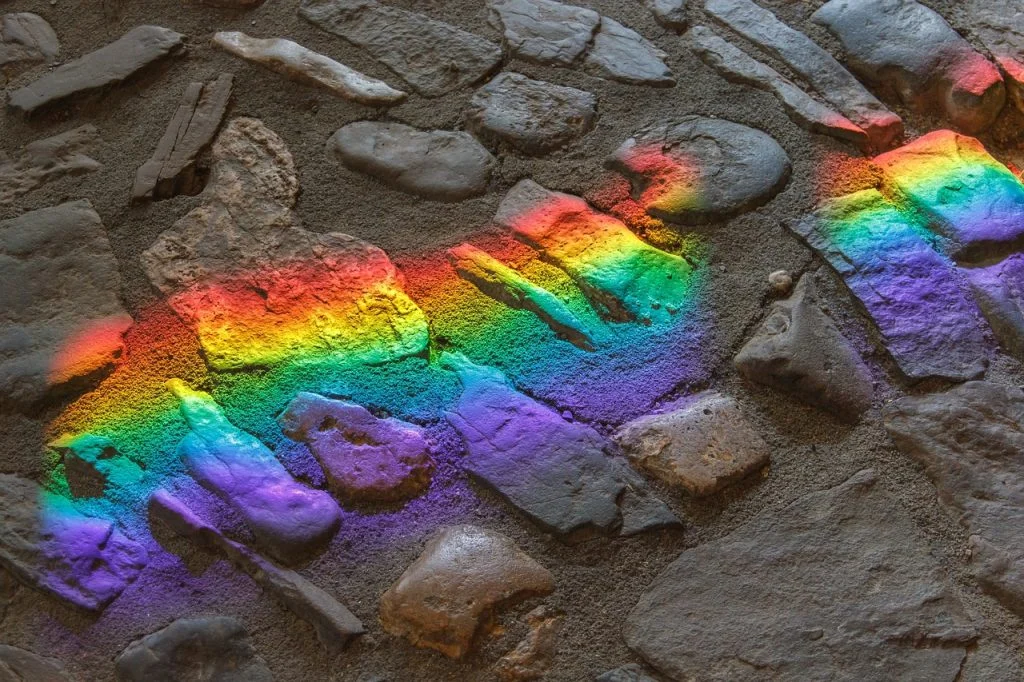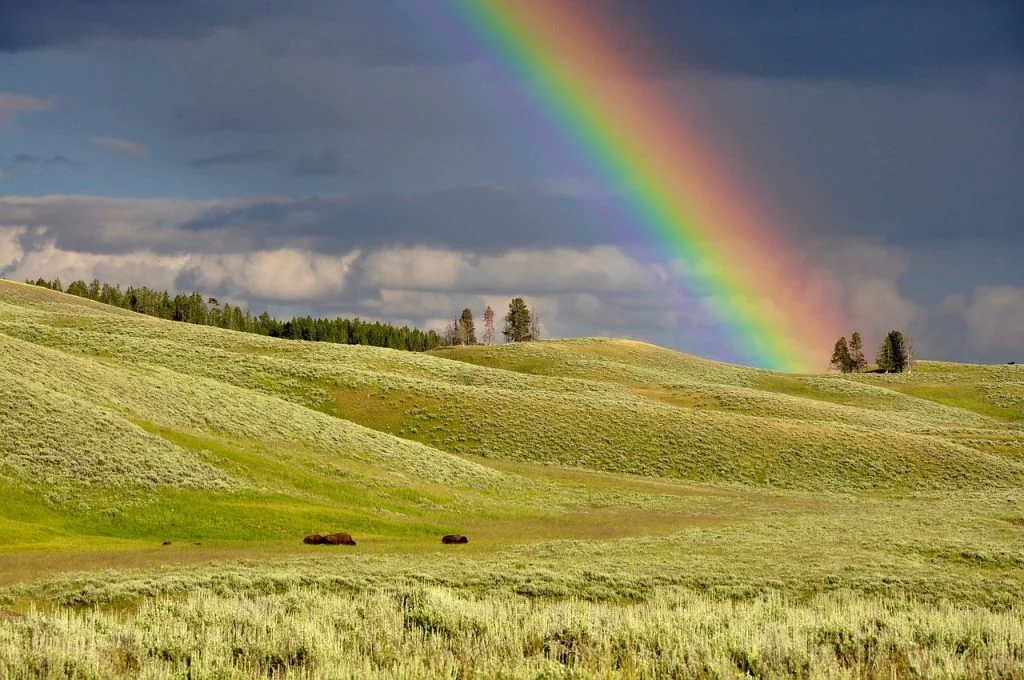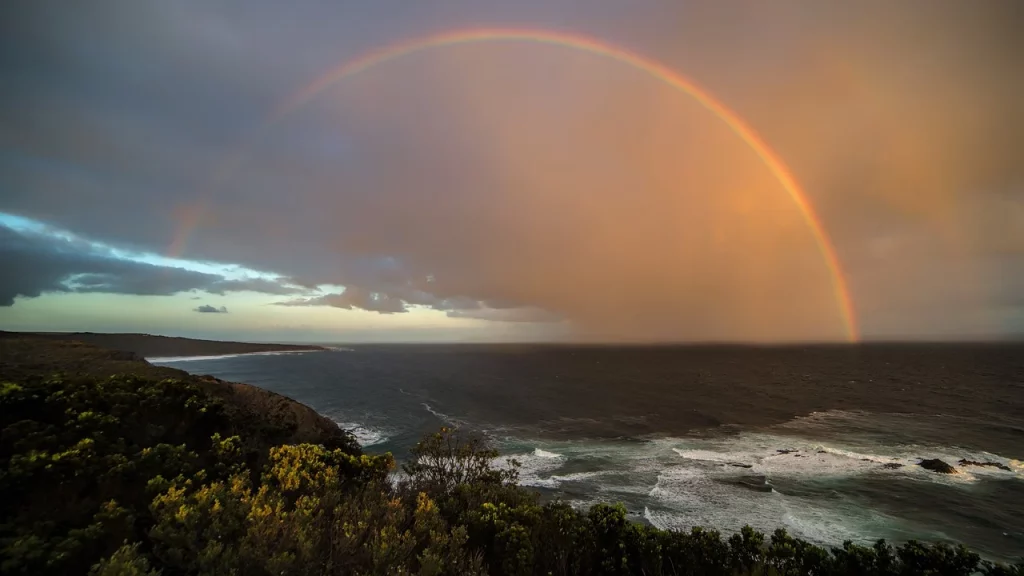Have you ever stood in excitement as a rainbow arched across the sky, its colors vibrant against the grey of a retreating storm? I have done it more times than I can count. Each rainbow I’ve witnessed has been a reminder of nature’s artistry, a fleeting masterpiece in the sky.
My fascination with these natural spectacles began as a child, when I first learned how sunlight and raindrops create them. Over the years, my interest has grown into a passion for uncovering every fact and mystery about rainbows.
Now, I invite you to join me on a colorful journey as we explore 50 fascinating facts about these celestial ribbons of light. Have you ever wondered why rainbows are circular or why they contain so many colors? Let’s find out together.
Try to be a rainbow in someone’s cloud.
Maya Angelou
Rainbow Facts
Dive into the colorful world of rainbows with me! Make sure to absorb every detail, as there’s an exciting, colorful quiz at the bottom of the page to test you.
- Rainbows are a meteorological phenomenon caused by reflection, refraction, and dispersion of light in water droplets.
- Primary rainbows form when light is reflected once inside a water droplet.
- A secondary rainbow is seen outside the primary arc and is fainter with colors reversed.
- Rainbows are full circles, but the ground usually prevents seeing the entire circle.
- The colors of a rainbow, in order, are red, orange, yellow, green, blue, indigo, and violet (ROYGBIV).
- A moonbow is a rainbow produced by moonlight rather than sunlight.
- Rainbows can appear near waterfalls due to the moisture in the air.
- The angle of light refraction needed to create a rainbow is 42 degrees.
- Rainbows are not physical objects; they cannot be touched.
- Double rainbows occur when sunlight is reflected twice inside a water droplet.
- Alexander’s band is the dark area between primary and secondary rainbows.
- Supernumerary rainbows are extra, fainter arcs inside the primary rainbow.
- Rainbows can be seen in the spray of a garden hose under the right conditions.

- A glory is a rainbow-like phenomenon seen around the shadow of an observer’s head.
- The order of colors in a secondary rainbow is opposite that of the primary rainbow.
- Red is always on the outer edge of the rainbow.
- Rainbows can occur anywhere with sunlight and water droplets in the atmosphere.
- The Greek philosopher Aristotle was one of the first to explore the nature of rainbows.
- In Norse mythology, a rainbow called the Bifröst connects the realms of the gods and humans.
- Circular rainbows are often observed from airplanes.
- Refraction separates sunlight into its component colors to form a rainbow.
- The radius of a primary rainbow is about 42 degrees around the antisolar point.
- A fogbow is a white rainbow that occurs in fog, which consists of very small water droplets.
- Twinned rainbows are rare and occur when two rain showers with different-sized droplets combine.
- Rainbows have been used in cultural symbols and mythology around the world.
- Reflection rainbows occur when sunlight reflects off a body of water before creating a rainbow.
- The width of a rainbow depends on the size of the raindrops.
- Isaac Newton is credited with first demonstrating that white light is made up of the colors of the rainbow.

- A fire rainbow is not a true rainbow, but a circumhorizontal arc caused by ice crystals in cirrus clouds.
- Rainbow Eucalyptus trees have bark that appears rainbow-colored.
- The Rainbow Serpent is a significant figure in Australian Aboriginal mythology.
- Monochrome rainbows appear in a single color, usually red.
- The Brocken spectre is a large shadow of an observer, cast upon clouds opposite the sun with a rainbow-like halo.
- During a lunar rainbow or moonbow, colors are often so faint that they appear white.
- A rainbow’s size appears larger the farther away you are from it.
- Underwater rainbows can be seen in the mist of underwater waterfalls in oceans.
- The colors of a rainbow are caused by the different wavelengths of light being refracted.
- Secondary rainbows have a dimmer and wider appearance than primary rainbows.
- A sundog is a bright spot that appears beside the sun, caused by ice crystals in the atmosphere.

- Artificial rainbows can be created with prisms and water sprays.
- The Rainbow Bridge in Norse mythology symbolizes a path between Earth and the afterlife.
- Rainbow Mountains in China and Peru are named for their multicolored rock formations.
- A rainbow’s arc is part of a circle centered on the antisolar point.
- The intensity of a rainbow’s colors depends on the size of the raindrops.
- A cloudbow or iridescent cloud is a rainbow-like phenomenon seen in clouds.
- The end of a rainbow is an optical effect; it has no physical location.
- Rainbows in art have been used to symbolize peace and hope.
- Light scattering off airborne particles can cause faint rainbows.
- A rainbow’s visibility is highest when the sky opposite the sun is dark with clouds.
- Alfred Wegener, known for his theory of continental drift, conducted early studies on rainbow optics and the role of water droplets in their formation.
Rainbow Myths

Beyond the clear skies of rainbow facts lies the intriguing horizon of rainbow myths. Let’s explore what’s true and what’s merely a mirage.
- Rainbows Can Be Touched
Rainbows are an optical phenomenon created by the refraction, reflection, and dispersion of light in water droplets, resulting in a spectrum of light appearing in the sky. They are not tangible objects and can’t be touched, akin to trying to catch a beam of sunlight in your hands. - There is a Pot of Gold at the End of a Rainbow
This charming folktale springs from Irish mythology. In reality, rainbows are circular and have no end, so the idea of finding a pot of gold at the end is a whimsical fantasy, much like imagining finding a unicorn at the end of a meadow. - Rainbows Only Occur After Rain
While rainbows are commonly seen after rain, they can actually occur whenever there are water droplets in the air and sunlight shining from behind at a low angle. This means you can also witness rainbows around mist, spray, and dew, not just after rain showers. - Rainbows Always Have Seven Colors
Rainbows typically display a continuous spectrum of colors. The “seven colors” notion is a simplification, attributed to Isaac Newton. In truth, a rainbow is a gradient of colors, much like a painter blending hues on a canvas. - Double Rainbows Are a Rare Occurrence
Double rainbows are less common than single rainbows but not exceedingly rare. They occur when light is reflected twice inside raindrops, producing a second arc with colors in the reverse order. Spotting one is like finding an extra scoop of ice cream in your bowl – delightful but not extraordinarily uncommon.
No products found.
Rainbow Quotes

Here are some colorful (or just my favorite) quotes about rainbows. These are my personal favorites, so if you have a different one, please let me know in the comments. I really want to hear yours.
If you want the rainbow, you gotta put up with the rain.
Dolly Parton
Dolly Parton’s quote metaphorically suggests that to experience beauty or success, one must endure hardships and challenges.
When it rains on your parade, look up rather than down. Without the rain, there would be no rainbow.
Gilbert K. Chesterton
Gilbert K. Chesterton advises seeing the positive side of challenging situations, implying that difficult times often lead to beautiful outcomes.
Let us be grateful to people who make us happy; they are the charming gardeners who make our souls blossom.
Paulo Coelho
Although not directly about rainbows, this quote by Paulo Coelho likens the joy brought by others to the beauty of a rainbow in our lives.
Clouds come floating into my life, no longer to carry rain or usher storm, but to add color to my sunset sky.
Rabindranath Tagore
Rabindranath Tagore’s poetic quote reflects on how life’s challenges (clouds) can surprisingly bring beauty and depth (rainbows) to our experiences.
Be a rainbow in someone else’s cloud.
Maya Angelou
Similar to Maya Angelou’s sentiment, this quote by Roy T. Bennett encourages us to be a source of happiness and hope for others.
Rainbow FAQ

I hope you got some inspiration from these quotes about rainbows. Let’s jump on some frequently asked questions. Keep your mind as bright as a rainbow because the next section is the quiz section.
- Do Rainbows Mean Good Luck?
Traditionally, rainbows have been seen as symbols of hope and good fortune. This belief stems from various cultural and mythological traditions. For instance, in Irish folklore, leprechauns are said to hide their pots of gold at a rainbow’s end. However, scientifically speaking, rainbows are meteorological phenomena and don’t have a direct connection to luck. - Are Rainbows Real?
Yes, rainbows are real. They occur in nature when sunlight and rain combine in a specific way. Light enters a water droplet, slows down, and bends as it goes from air to denser water. The light reflects off the inside surface of the droplet, breaks up into its component wavelengths—or colors—and exits the droplet. This process, called refraction, creates the colorful arc we see in the sky. - Can Rainbows Happen at Night?
Rainbows typically occur during the daytime, but there’s a special kind known as a “moonbow,” which can happen at night. Moonbows are much rarer and less colorful than daytime rainbows because moonlight isn’t as bright as sunlight. They require a full moon and moisture (like rain or mist) in the opposite direction of the moon. - How Do Rainbows Work?
Rainbows are formed due to the refraction, reflection, and dispersion of light in water droplets. When sunlight enters a raindrop, it’s refracted (bent) and split into its spectrum of colors. This light then reflects off the inner surface of the droplet and exits, refracted again. The continuous process in numerous droplets leads to a circular arc of colors visible from certain angles. - Are Rainbows a Full Circle?
Rainbows are actually full circles, but we typically see only a semi-circular arc. The full circle is usually obscured because the earth’s horizon blocks the bottom half. However, from an elevated viewpoint, like a high mountain or an airplane, it’s possible to see the entire circular rainbow.
No products found.
Rainbow Trivia

Get ready for a colorful challenge in my Rainbow Quiz! But beware; fail to answer correctly, and you’ll only see shades of gray for a week!
Conclusion
The potpourri of rainbow facts that’s more colorful than your grandma’s patchwork quilt has come to an end. We’ve journeyed from the science behind these arc-shaped wonders to the myths that have danced around them for centuries.
Who knew that a simple mix of sunlight and raindrops could stir up such a spectacle in the sky? And let’s not forget about that elusive pot of gold. (Still searching, by the way.)
So, next time you spot a rainbow, remember that it’s not just a pretty face in the sky; it’s a cosmic catwalk of light and color. Now, the million-dollar question: If you were a leprechaun, where would you hide your pot of gold? Behind a cloud or under a tree? Share your secret stash location in the comments!
15 Sources Used For This ArticleCan you touch the end of a rainbow? – Coalition Brewing
Why Do Rainbows Appear In The Sky – Micro B Life
Rainbows – Wikipedia
Rainbows: Colorful Arcs: The Phenomenon of Rainbows – Faster Capital
Rainbow – En Academic
Rainbow – New World Encyclopedia
Rainbows – National Geographics
What Does Seeing Rainbows Mean? – Blogging E How
7 types of rainbows: Nature’s mesmerizing optical phenomena – Interesting Engineering
Rainbow Facts – Konnect HQ
Where is the rainbow sand? – Ncesc
Can Rainbows Touch the Ground? – G Celt
Rainbow Meaning and Symbolism: Unraveling the Beauty and Mystery – Symbol Hippo
Decoding The Rainbows – Linkedin


